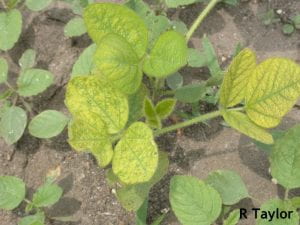Richard Taylor, Extension Agronomist; rtaylor@udel.edu
Most of us have become used to planting double-crop soybeans so early that we could be surprised this year by the height of the soybean crop when flowering begins. In a study that Bob Uniatowski and I did a number of years ago, we found that the beginning of the bloom period in a soybean crop was not impacted so much by a late planting date but rather by the stage of growth of the crop. Essentially, we found that regardless of how late we planted (all the way into August), the crop needed to reach the V3 or V4 growth stage (fully developed leaves on 3 or 4 nodes on the main stem counting the node with the unifoliate leaves as the first node). Hopefully, you remember that a fully developed leaf is one where the leaf immediately above it on the main stem has opened or unrolled sufficiently that the leaf edges of the three leaflets are not touching.
For those growers who are used to planting by mid- to late-June and having the plants grow so much that they are well above the small grain stubble before they begin to flower, this year will not follow that pattern. In July planted soybeans, chances are that as soon at the crop reaches the V3 or V4 growth stage, it will begin to flower. The result of this will be that the crop will be much shorter than you are used to seeing it when it reaches full bloom and final harvest height may be less than you are accustomed to seeing.
Interveinal chlorosis of the upper younger leaves on soybean typical of manganese deficiency. Note that even some of the weeds present show some indication of interveinal chlorosis.
Why is this critical to soybean growers? In Delaware, we often see areas in fields that show manganese (Mn) deficiency on soybeans. In the past, we’ve had a pretty wide window to apply foliar Mn to take care of the symptoms (see photo below) without impacting to a great degree our yield potential. With this year’s crop likely to begin the bloom phase as soon as they reach the V3 to V4 growth stage, it will be critical for growers to get foliar Mn applied as soon as they begin to notice the symptoms [interveinal chlorosis (green veins and yellow to white between the veins) on the upper leaves]. Foliar Mn is very effective in reducing or eliminating the yield loss associated with Mn deficiency according to data from researchers in Virginia and North Carolina as well as our own research. However, the Mn must be applied before it hurts pod set, flower number, and seed fill. With the very short time between the plants becoming visible out of the small grain stubble and their reaching flowering, scouting fields and responding with foliar Mn will be critical to obtaining maximum yield for double-crop soybeans.

